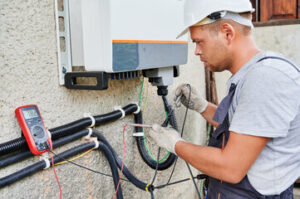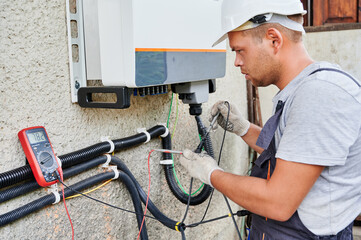Having a backup generator is the best way to make sure your family’s safety and comfort are protected during power outages. However installing a generator can be a complicated process.

Before you start, you’ll need to find a reputable electrician and plumber who specialize in generator installation. Ask for at least three quotes.
When it comes to generator installation, location is everything. It determines how much work will need to be done, where to place the unit, and what it takes to get a permit for it.
The location of the generator should be safe and not subject to the elements. It also needs to be far enough away from the home to avoid sending carbon monoxide into the house through open windows, doors, or vents.
A good contractor will help you find the best location for your generator and will know exactly what permits are needed in your area. This will allow them to get the job done quickly and efficiently.
If possible, the installer should place the generator on a concrete pad that is leveled before they start to work. This will ensure that the generator is stable and will not move due to vibrations while it is running.
Another option is to have the generator installed near the electric and gas meters. This way, the gas piping does not have to run as far to reach the generator, saving you money on the installation.
This is especially true if the meter is on the same side of the home as the electrical circuit box, which can help cut down on the amount of wiring that needs to be run. It is also important to consider homeowners’ association rules and community restrictions when choosing a location for the generator.
It is also a good idea to choose a location that has fresh air coming in and out. This is because the generator will constantly be running and producing exhaust fumes, which can be dangerous to humans and pets alike.
The location should also be one that is not susceptible to water damage. This is because the exhaust can leak from the generator through small holes and voids in your home.
The location should also have a clear space around it for the technicians and maintenance people to have room to work. This is important because the generator needs to have room to move around and to perform any maintenance that may be required.
The size of your generator installation depends on a number of factors, including your home’s square footage and power requirements. The more appliances you have to power, the larger the generator should be.
Sizing your generator is a difficult task, but one that can save you money and frustration down the road. To get started, you need to first figure out exactly what appliances you want to be able to keep powered during an outage or power shortage. You can do this by completing a walkthrough of your home, identifying which appliances are essential, and determining what wattages they require.
After identifying all the devices you want to power, add up their wattages and multiply them by the number of hours you plan to run them during an outage or power shortage. This will give you a general idea of the size of generator you need to purchase.
A more detailed and accurate way to size your generator is to consult with a professional. The electrician will be able to identify the power needs of your entire house and make recommendations about the best size generator for your home.
For homes that do not have a large amount of electrical demand, such as small apartments and condominiums, a smaller generator may suffice. A bigger generator is required for homes with larger electrical loads, such as electric furnaces and refrigerators.
In addition to powering your household appliances, generators can also be used to supply electricity for things like lighting and sump pumps. These are especially important if you live in an area that experiences severe weather or frequent power outages.
To calculate the size of a generator, use a sizing calculator that factors in your home’s square footage and other requirements. This calculator will also determine how much wattage your generator should be able to produce.
Next, you need to factor in your generator’s reserve capacity. This is an additional kilowatt of power that it can provide to your household for additional safety and future needs.
The sizing calculator that Woodstock Power provides can help you decide on a generator that is the right size for your home’s needs. This sizing calculator will also allow you to select an appropriate generator fuel type for your needs.
Electric generators are essential for powering a large facility during an outage, so it’s important to keep them running properly. It’s also vital to ensure that they are safe and do not pose a threat to people or property.
Keeping your generator installation properly maintained will improve its performance and lifespan, as well as help you avoid costly repairs. Taking care of your generators on a regular basis will also allow you to detect issues early and have them fixed before they escalate into more serious problems.
To get the most out of your generator, you should schedule maintenance appointments at least twice a year. The first appointment should include an oil change and a thorough inspection, including checking for leaks and any other potential issues.
The second appointment should involve a 2-4-hour load bank test, depending on the specific needs of your generator. This will get rid of any wet stacking, which is the buildup of carbon deposits and unburned fuel that can cause your generator to smoke and run sub-optimally.
Performing routine maintenance will also increase the life span of your generator by eliminating wear and tear that causes parts to break down or fail. Technicians will make sure that all of the parts in your generator are up-to-date and replaced when necessary.
They will also perform a detailed visual inspection to check for loose or damaged wires, hoses, and clamps. In addition, they will examine the enclosure, engine coolant heater, exhaust system, DC electrical system, AC wiring and accessories, and the battery electrolyte level and specific gravity.
Another critical step in a generator maintenance plan is to clean the unit regularly. Use a cloth and non-flammable degreaser to wipe away any dirt or debris. It’s also recommended that you vacuum the inside of your generator, as this will help remove any debris that may be trapped in it.
Whether you have an enclosed or open-air system, it’s always a good idea to run the generator for 10 minutes a couple of times a month. This will help it heat up and drain the oil, allowing you to replace it with fresh oil.
Generators are a necessity during power outages, but they can pose dangerous risks if they are not properly installed and used. They can cause fires, damage electrical equipment, and give off deadly levels of carbon monoxide.
To avoid these problems, be sure that the installation of your new generator is done in accordance with your local building codes and manufacturer guidelines. The generator should be placed on a level, non-flammable surface that is not conductive and at least three feet away from any opening in the house.
It’s also important to keep the generator as far from water sources as possible, particularly during monsoons. If the generator is exposed to puddles of rainwater, it can become extremely hot.
When installing a generator, be sure that it is located on a concrete pad or other flat surface that is stable and level. This will ensure that it doesn’t tilt due to weight or vibration.
Ideally, the generator should be located near the gas and electric meters for a more consistent fuel supply. This will reduce the time that the generator spends in the fuel tank, which will improve its reliability and extend its lifespan.
The generator should be connected to your home’s electrical system by a transfer switch. A transfer switch separates your generator’s electrical system from the utility’s, and it can help prevent back-feeding. This occurs when the generator begins to feed electricity into your home’s wiring, which can cause a surge in your power supply and potentially injure an unaware utility lineman who may be working in the area.
Installing a transfer switch can cost a few hundred dollars, but it will save you money in the long run. It will also protect you from back-feeding, which can cause damage to your home’s wiring and lead to a fire.
Before deciding where to put your generator, you should contact a qualified professional who will be able to advise you on the best location. You can also ask your utility company for recommendations.

